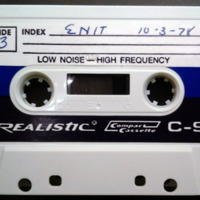
Browse Items (6 total)
Sort by:
-
Pat and DJ, November 11, 1986 (Tape 3)
Side A: Pat and DJ discuss the characteristics of femme identity. The interviewers say they are looking to interview more femmes, which leads to a discussion of the names and locations of lesbians who were a part of the community in the 1940s. The interviewers also mention the difficulties of interviewing lesbians who have not come out. The group discusses why butches are more willing to talk. Pat talks about her time at the Good Shepherd home. There is a brief discussion about the role of lesbians in World War II.
Cut off at 0:14:55
Side B: The group continues their discussion of the interview process, including who is willing to talk and who is not, as well as who will use their names and who will not. There is more discussion about beatings. Pat tells of coming out to her mother. Her mother only worries about the violence Pat is subjected to, on account of being butch. There is a long discussion about the nature of breakups and their aftermath. The group discusses the role of third parties in most breakups and the way a butch or femme reacts to a breakup. The issue of "passing" comes up, and Pat talks about working as a cab driver and passing as a man. Often, the children of femmes did not know that their mothers' partners were actually women. The interview concludes with a description of the rules for asking other butches' girlfriends to dance, and the fights that sometimes ensued. This point in the discussion highlights the difference between the generation of the interviewees and the generation of the interviewers. -
Mabel Hampton, 1982 (Tape 1)
Side A: Some discussion of when Mabel first heard the word lesbian, her experiences as a dancer. Side B: Mable describes her experiences caring for children, finding freedom as a child, running away from her aunt and uncle to New Jersey to live with the White family, and her spirituality. -
Linda, November 19, 1978 (Tape 1)
Linda talks about her relationships and the idea there are no longer clearly defined lesbian roles (i.e. butch and femme) in relationships, as there were when she first came out in the 1960s. She describes her family life growing up and when she came out to her family. -
GWA Rough Cut and Crawl Titles
Del Martin, Phyllis Lyon, Billye Talmadge, Nikki Nichols, and Barbara Gittings speak about their experiences with the Daughters of Bilitis organization. -
Enit, October 3, 1978 (Tape 2)
Enit discusses how her perception of Lesbian oppression has changed over time. She also talks about acceptance in the work place and how professionals view Lesbians. Enit explains that her personal interests have changed with age and that her hobby is dance. She finishes by discussing her interactions with straight women and the support she gets from her Lesbian friends. -
Astraea
Short clips of several interviews with various members of the Daughters of Bilitis about their experiences with the group and being a lesbian in the 1950s and thereafter.





